Do you have a question about the Toyota SP100 Series and is the answer not in the manual?
Essential safety guidelines for operating the sewing machine, covering electrical hazards and personal injury prevention.
A reminder to retain the instruction manual for future reference and guidance.
List and identification of all included accessories provided with the sewing machine.
Visual identification and labeling of the main parts of the sewing machine.
Explanation of the accessory storage area and the operation of the presser foot lever.
Description of the handwheel, pattern selection dial, and reverse sewing lever functions.
Instructions on how to locate and open the quick adviser feature on the sewing machine.
Step-by-step guide on how to connect and operate the foot controller for sewing machine speed control.
Detailed instructions on safely connecting the sewing machine to a power source.
Step-by-step guide on how to properly wind thread onto the bobbin.
Further steps and details for successfully winding thread onto the bobbin.
Instructions for correctly inserting the bobbin into the bobbin case for sewing.
Final steps for closing the bobbin case cover after threading the lower thread.
Guide to correctly threading the upper thread through the machine and into the needle.
Final steps in threading the upper thread, including passing through the take-up lever and guides.
Instructions on preparing the machine and understanding the needle threader mechanism.
Detailed steps for operating the needle threader to automatically thread the needle.
Steps to bring the lower bobbin thread up to the needle area before starting to sew.
Overview of various stitch patterns and their applications on different models.
Detailed steps for safely removing the presser foot from the sewing machine.
Instructions for safely attaching the presser foot to the sewing machine.
Instructions for removing the presser foot holder assembly.
Instructions for installing the presser foot holder assembly securely.
Step-by-step guide on how to correctly remove and insert sewing machine needles.
Guidance on selecting appropriate needles and threads, and adjusting tension based on fabric.
Instructions for performing basic straight stitches and reverse sewing for reinforcement.
How to use the thread cutter and the function of reverse sewing for preventing unraveling.
Tips for sewing challenging fabrics like thick denim or thin materials to prevent puckering.
Method for sewing cylindrical items like sleeves or trouser legs using the free arm.
Guide to setting up and performing zigzag stitches for various applications like appliqué.
How to adjust the upper thread tension to achieve balanced stitches on different fabrics.
Step-by-step instructions for sewing buttonholes of various sizes and types.
How to fine-tune the buttonhole balance for a neat and even finish.
Method for overcasting fabric edges to prevent fraying and improve seam durability.
Guide on how to properly install zippers using the appropriate presser foot.
Instructions for sewing invisible or blind hems that are not visible from the fabric's right side.
Common issues and solutions for blind hem stitching, such as stitch balance or needle catching.
Specific instructions for hemming jeans, including the use of the gliding foot for thick fabrics.
Advice on selecting the correct needle and thread combination for optimal sewing results.
Steps involved in measuring, marking, and folding jeans for the hemming process.
How to use the quilting guide for consistent hemming and sewing parallel to edges.
Instructions for attaching piping or welting to fabric edges using the piping/zipper foot.
Procedure for cleaning the feed dog and hook to ensure smooth operation and prevent noise.
Detailed steps for correctly inserting and securing the bobbin case into the sewing machine.
Final steps for reattaching the needle plate and presser foot after maintenance.
Instructions for safely replacing the sewing machine's light bulb.
Common causes and solutions when the sewing machine fails to operate, including power and switch checks.
Diagnosing and fixing issues causing the machine to be noisy or operate slowly, often related to lint or spindle position.
Addressing frequent needle breakage by checking needle insertion, clamp screw tightness, and needle/fabric suitability.
Troubleshooting common causes for upper thread breakage, such as tension, tangling, or incorrect threading.
Solutions for lower thread breakage, including incorrect threading or poor quality thread.
Addressing issues where the fabric is not feeding correctly, possibly due to feed dog cleanliness or stitch selection.
Identifying causes for missed stitches and fabric wrinkling/puckering, and their solutions.
Correcting the appearance of lower thread on the fabric surface, usually due to upper thread tension or bobbin type.
Resolving issues where the upper thread appears on the underside of the fabric, typically due to loose upper tension or incorrect threading.
Troubleshooting problems with the automatic needle threader, checking needle position, size, and threading guide.
Technical specifications for the SP100 series sewing machines, including model variants and electrical data.
| Adjustable Stitch Length | Yes |
|---|---|
| Adjustable Stitch Width | Yes |
| Speed | 750 stitches per minute |
| Weight | 6.5 kg |
| Buttonhole | 1-step |
| Stitch Types | Decorative |
| Presser Feet | Buttonhole |
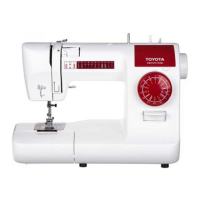

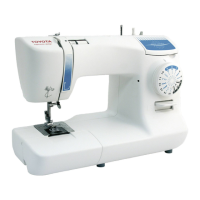

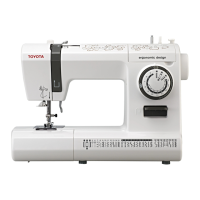
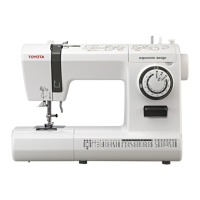

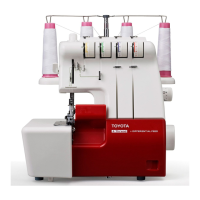
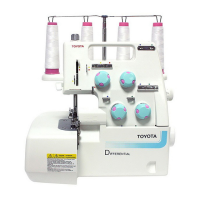

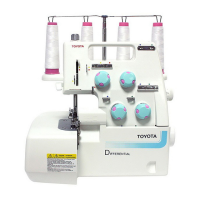
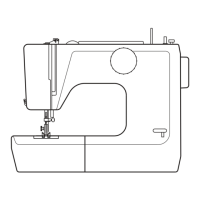
